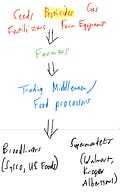The Monopolists on the Farm
Rural America is in trouble.. Finally, the Federal Trade Commission is doing something about it, in this case focusing on pesticide monopolists.
Welcome to BIG, a newsletter on the politics of monopoly power. If you’d like to sign up to receive issues over email, you can do so here
Late last month, the Federal Trade Commission revealed it was working with ten state attorneys general, including Texas uber-conservative Ken Paxton, to sue two dominant firms who sell pesticides at elevated prices. They are specifically going after two firms - Syngenta, a Chinese-owned seed and chemical firm, and Corteva, which was the merger of two parts of U.S. firms, Dow and DuPont.
There are a few interesting aspects of this case. First, it has to do with farmers, who are being extorted on both sides of their business. Lina Khan is not only doing this with state enforcers, but also wrote an oped in the Des Moines Register explicitly signaling to rural America that the goal of the FTC is to stop middlemen from preying on farmers.
The monopoly problem farmers face is really bad. On the input side they must deal with equipment producer John Deere, fertilizer giants CF Industries and Nutrien, and seed/chemical goliaths Bayer/Monsanto, among others. On the other side, they face giant buyers like ADM, Bunge, Cargill and Louis Dreyfuss, who in turn sell to large supermarket chains like Walmart and Kroger, and broadliners Sysco and U.S. Foods who sell to restaurants, institutional facilities, and food service giants. It’s consolidation all the way up and down the chain.
This move by the FTC, to address one small part of the input side, is a meaningful start. If it works, then farmers can bring their own suits without waiting from the government. Here’s a badly drawn graphic showing the basic problem farmers face.
The products at issue are fungicides and herbicides (Azoxystrobin, Metolachlor, Mesotrione, Oxamyl, Acetochlor) used on corn, apples, peanuts, citrus fruits, pears, carrots, peppers, tomatoes, tobacco, sugarcane, etc. pretty much anything you can grow. Corteva and Syngenta have essentially been paying distributors not to carry rival, cheaper products, so they can maintain higher prices. This is done under the veil of “loyalty” programs, but it’s a way of blocking competition and keeping prices high.
In attacking this arrangement, the FTC is resurrecting dormant legal tools. The commission is filing under the Clayton Act Section III, a law prohibiting certain exclusive dealing arrangements. This provision hasn’t really been used in decades, and its use is a direct attack on the status quo antitrust establishment. This is a bit technical, so bear with me. The Sherman Antitrust Act on such arrangements usually requires a judge to hear all the evidence and make a decision about whether output has been hindered. Doing so requires lots of economic analysis and is done under a consumer welfare test involving price theory.
But the Clayton Act is a different more recent law, and under key court precedent (Standard Stations in 1949), judges have much less discretion. One must only prove that Syngenta or Corteva control a significant share of the market, and that they are blocking rivals. You don’t have to prove prices are affected, just that the structural behavior is happening. There are other reasons why the FTC’s legal approach is innovative, but that’s the main one.
So basically, there are two lessons to take from this lawsuit. One, Lina Khan led bipartisan antitrust suit, using provisions of the Clayton Act that had been dormant for decades, to stop Wall Street from attacking the American farmer. Two, my handwriting is horrible.


